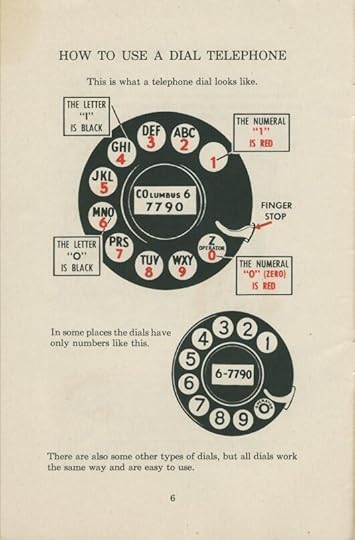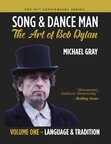Michael Gray's Blog, page 15
March 29, 2013
JELLY ROLL MORTON'S SMOKEHOUSE BLUES
This isn't at all my usual kind of music, but an enthusiast played me this track as we were sitting in his pleasant French farmhouse the other week, and it sounded terrific - full of life and sunshine, despite its title:
I don't know what Robert Crumb would feel about this rare British reissue from the 1950s; maybe he owns a copy.
Jelly Roll Morton died in 1941, 20 years before his lookalike was born.
 White House / Smokehouse
White House / Smokehouse
I don't know what Robert Crumb would feel about this rare British reissue from the 1950s; maybe he owns a copy.
Jelly Roll Morton died in 1941, 20 years before his lookalike was born.
 White House / Smokehouse
White House / Smokehouse
Published on March 29, 2013 12:48
March 27, 2013
ROBERT CRUMB ON COLLECTING OLD RECORDS
There's a terrific 2013 interview with Robert Crumb, about collecting & obsession in general and old 78rpm records in particular,
here at Discaholic Corner
. It comes with this comic self-criticism from 1977:
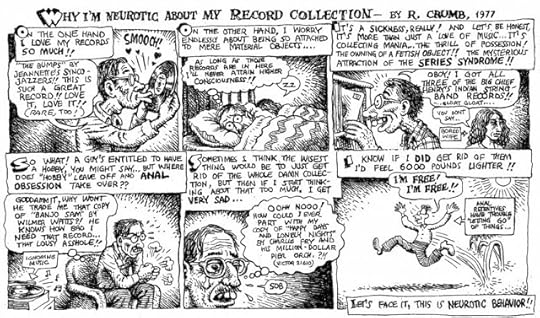
and, at the end, this quote: “We humans with all our intelligence and cleverness are helpless creatures driven by forces over which we have very little control and which we barely understand. Who can fathom the collecting compulsion? It’s not something to be proud of, though it’s certainly not the worst human trait."
What never gets discussed in the interview is the observable fact that 99.999% of serious collecting prolonged into adulthood is by men and not by women. Completists, listmakers, those who remember the matrix numbers of prized-possession records: men.

and, at the end, this quote: “We humans with all our intelligence and cleverness are helpless creatures driven by forces over which we have very little control and which we barely understand. Who can fathom the collecting compulsion? It’s not something to be proud of, though it’s certainly not the worst human trait."
What never gets discussed in the interview is the observable fact that 99.999% of serious collecting prolonged into adulthood is by men and not by women. Completists, listmakers, those who remember the matrix numbers of prized-possession records: men.
Published on March 27, 2013 01:49
March 26, 2013
IZZY IZ 85 YEARS YOUNG
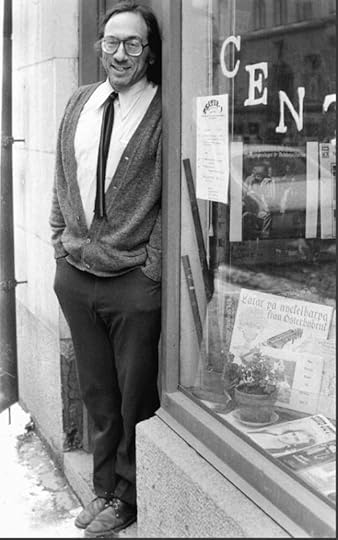 photograph © Birgitta Olsson
photograph © Birgitta OlssonToday (March 26, 2013) is the 85th birthday of Israel Goodman Young, widely known as Izzy Young. Here is the substantial entry on him in The Bob Dylan Encyclopedia:
Young, Izzy [1928 - ]Israel Goodman Young was born in New York City on March 26, 1928. He grew up working in his parents’ Brooklyn bakery and first encountered folk music in 1945 when on impulse he joined Margaret Mayo’s American Square Dance Group. He attended Leadbelly’s last concert in New York City in 1949, and the concert at his funeral a few months later. He dropped out of Brooklyn College in 1950 and in the mid-1950s met the eminent folklorist Kenneth S. Goldstein, whose encouragement steered him toward folk revival activity, starting by compiling a 15-page listing of rare publications. He was the founder of the Folklore Center, at 110 MacDougal Street, Greenwich Village, which he opened in March 1957 after cashing in a $1000 insurance policy to pay for the lease. ‘I had about $50 in the bank,’ he said later, ‘and I had a batch of books I put up on the shelves and a few records, and I started doing business from the first minute.’ The idea of the place was to supply the would-be folk musician’s needs: records, sheet music, second-hand guitars, strings, capos, Sing Out! magazine and more. It was also, perhaps inevitably, a place for like-minded Villagers bump into each other and hang out, especially in a back room ‘with a pot-bellied stove, crooked pictures and rickety chairs’, as Dylan describes it in Chronicles. ‘Some people,’ he recalls, ‘picked up their mail there.’ Dylan’s descriptions of Young and his Folklore Center are, in a book of great vivacity and detail, especially vivid. He begins by hinting at their importance to him, saying that he started avoiding the Café Wha in the afternoons and hanging out at the Center instead. ‘The small store was up a flight of stairs and the place had an antique grace. It was like an ancient chapel, like a shoebox sized institution.’ The back room with the stove, he says, had ‘old patriots and heroes on the wall, pottery with crossed-stitch design, lacquered black candles’ and ‘was filled with American records and a phonograph. Izzy would let me stay back there and listen to them’ and even thumb ‘through a lot of his antediluvian folk scrolls… Extinct song folios of every type - sea shanties, Civil War songs, cowboy songs, song of lament, church house songs, anti-Jim Crow songs, union songs - archaic books of folk tales, Wobbly journals, propaganda pamphlets…’ (Young gave him pamphlets on Joe Hill to read, after Dylan asked who Hill was.) The center was ‘the citadel of Americana folk music… a crossroads junction for all the folk activity you could name and you might at any time see real hard-line folksingers in there… I saw CLARENCE ASHLEY, Gus Cannon, MANCE LIPSCOMB, TOM PALEY, Erik Darling hanging around in the place.’ It was here that Dylan first encountered DAVE VAN RONK, stepping in off the snowy street to look at a Gibson guitar. Young himself was ‘an old-line folk enthusiast, very sardonic and wore heavy horn-rimmed glasses, spoke in a thick Brooklyn dialect, wore wool slacks, skinny belt and work boots, tie at a careless slant. His voice… always seemed too loud for the little room. Izzy was always a little rattled over something or other. He was sloppily good natured. In reality, a romantic. To him, folk music glittered like a mound of gold.’ Not everyone found him so good-natured: he often showed a short temper, occasionally a physically violent one, and could be intractable in nursing small imagined slights. At some point Young started writing a news-snippets and gossip column for Sing Out!, called ‘Frets and Frails’, and kept a journal in which, invaluably in retrospect, he logged the comings and goings of his musician-customers - including Bob Dylan. (Examples: ‘September 23, 1961: Met Bob Dylan 3am this morning on the way to a JACK ELLIOTT party at 1 Sheridan Square…Terry Thal now a manager. Tom Paxton, Bob Dylan and someone else.’ ‘January 26, 1962: Passed Dylan on the street, he said to me that he “didn’t know why so many things are happening to me.” I said that he did.’) JOHN BAULDIE described him as ‘a loud, disorganised, big-hearted folk enthusiast’ at whose center Dylan spent a lot of time, ‘looking at records, music, trying out instruments, meeting people and, later, writing songs in the back room on Izzy’s old typewriter. One of them, the unreleased “Talkin’ Folklore Center”, was specially composed on March 19, 1962 as a fund-raiser.’ The previous October, when Young was interviewing Dylan for his journal, Dylan mentioned another composition, ‘California Brown Eyed Baby’, which he said he was performing at the time. Dylan credits Young with fighting city hall to allow music in Washington Square Park, and in general fighting against ‘injustice, hunger and homelessness’. More personally, though, he credits Young with having played him particular records as suggested pieces of repertoire for him, and even being so trustworthy that Dylan told him truths about his own family (a rare thing indeed). It was also Young who, at ALBERT GROSSMAN’s prompting, promoted Dylan’s first real concert, at the Carnegie Chapter Hall on November 4, 1961 - at which Bob performed 21 songs, finishing with the two of his own he would record later that month for his début album, ‘Song To Woody’ and ‘Talkin’ New York’ . . . to an audience of 52. Young was not a great businessman, as Dylan comments: ‘Young as beseiged with bill collectors and dictates from the landlord. People were always chasing him down for money, but it didn’t seem to faze him.’ He’s likely to have been one of those Dylan hit out against later, in ‘Positively 4th Street’. By 1965 Young was highly critical of Dylan’s move away from overt political songs, and he wrote a piece in the first issue of the radically underground East Village Other, published that October, after being angered by the absence, at an anti-war rally, of all Albert Grossman’s artists. Looking back over Dylan’s earlier years he saw them anew: ‘…everyone conveniently forgot that he allowed Columbia Records to delete “John Birch Society Talking Blues” from his second album. This was soon after he swore that Columbia would have its way over his dead body. (I was hoodwinked… into arranging an abortive protest march… Dylan and management pulled a no-show on our six brave marchers.)’ He added that Dylan copyrighted work that ‘reflected accurately’ that of ‘poets from Patchen to Ginsberg’ and ‘no-one complained’; that he went to England, ‘picked up marvelous morsels’ and then ‘left the poets and England behind.’ He added: ‘There seemed no heights to which Dylan could not attain. He had only to meet the right person. If he could only meet Malraux he could write treatises on civilization’. And so on. Young said in 1992 that he sent this article to Dylan before it was published, and that Dylan ‘always said it was the best single article ever written on him’. In the fullness of time, Young was back on board the Dylan bus, giving a warm and generous interview to JEFF ROSEN for the MARTIN SCORSESE film No Direction Home, in which he appears. One story he tells in the film, however, is untrue. It was not Young but BOB YELLIN of THE GREENBRIAR BOYS who tried to get Maynard Solomon to sign Dylan to Vanguard - he took him a tape - and the remark Young has Solomon making about not signing ‘freaks’ does not ring true as the speech of the gently-spoken, good-humoured Solomon. When Chronicles appeared, Young was thrilled and gratified by Dylan’s detailed, affectionate recall. ‘No matter what else Dylan has done his starting point has always been folk music. He never leaves folk music and he never will.’ And: ‘The book he promised to write, with a chapter on me, in July 1962 has finally come true!’ Young handed over the Folklore Center to Rick Altman in 1973, moved to Sweden and there opened the Folklore Centrum in Stockholm. He and it are still going. [Bob Dylan: Chronicles, 2004, pp.18-22; Joe Hill pamphlets p.52. Izzy Young background detail in part from Ronnie D. Lankford Jr., All Music Guide, seen online 5 Oct 2005 at www.icebergradio.com/artist/499028/iz.... Izzy Young journal extracts Judas! no.12, Huntingdon UK, Jan 2005 p.53; article ‘Bob Dylantaunt’, East Village Other vol.1, no.1, NYC, Oct 1965, republished Judas! no.10, Jul 2004, pp. 87-88; response to Chronicles, written 20 Jun 2005, Judas! no.14, Jul 2005, p.34. John Bauldie, ‘Village Walking Tour’, online 5 Oct 2005 www.interferenze.com/bcs/villagesight....]
Published on March 26, 2013 02:33
March 16, 2013
QUAINTNESS OF THE RECENT PAST NO. 30
The legendary Ford Edsel, still believed to be the greatest failure in the history of car sales, but now looking completely brilliant. I'd love one:
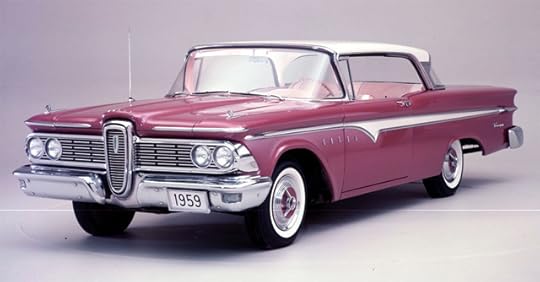

Published on March 16, 2013 06:26
MAP 13: ACCENTS, UK & IRELAND
Published on March 16, 2013 03:21
March 13, 2013
TEITUR: GREAT SONG & FINE PERFORMANCE
Teitur performing one of the strongest, sweetest songs from his 2nd album, here live in Bonn, 2011:
Published on March 13, 2013 10:54
March 12, 2013
QUAINTNESS OF THE RECENT PAST NO. 29
Published on March 12, 2013 08:31
March 8, 2013
THE BOB DYLAN ENCYCLOPEDIA
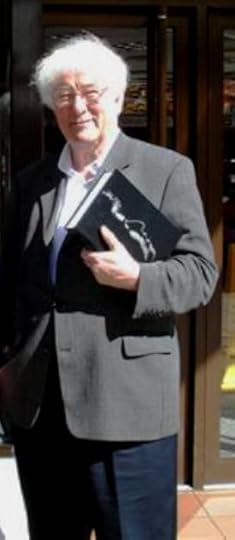 Seamus Heaney and the book, 2006I still have a few original 1st edition hardbacks of The Bob Dylan Encyclopedia, 2006, on offer at £25 each (P&P included), each signed and including a fully searchable CD-Rom of the whole 750,000-word text. These will soon be unavailable from any bookshop, including Amazon. They are now available from
the Shop page of my website
while this limited stock lasts.
Seamus Heaney and the book, 2006I still have a few original 1st edition hardbacks of The Bob Dylan Encyclopedia, 2006, on offer at £25 each (P&P included), each signed and including a fully searchable CD-Rom of the whole 750,000-word text. These will soon be unavailable from any bookshop, including Amazon. They are now available from
the Shop page of my website
while this limited stock lasts.
Published on March 08, 2013 00:35
March 7, 2013
ALLMAN BROTHERS DEBUT 'TEARS OF RAGE'
I wish I'd been back at the Beacon Theatre in New York the other night (for the first time since Bob Dylan's concerts there in 1989) for the Allman Brothers concert at which they played the Dylan/Manuel song 'Tears Of Rage', and beautifully:
Published on March 07, 2013 06:25
March 3, 2013
QUAINTNESS OF THE RECENT PAST NO. 28
Teddy Redell on piano and vocals for Vaden Records of Trumann, Arkansas. I love the way it says that on the label. That label embodies a thrilling kind of quaintness in itself.
Redell also wrote and recorded the original of 'Judy', which Elvis covered rather beautifully in 1961 on the Something For Everybody album.
Published on March 03, 2013 08:04


